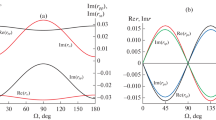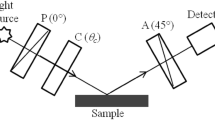Abstract
We have modeled most errors, which affect the measurement accuracy, with Jone’s matrix. From the simulation, we can characterize the errors and take good aids for selecting components and designing ellipsometer. The traditional residual method has good performance when there are only azimuth angle errors and extinction errors, but it has not good performance when there are other errors. We have proposed the optimal calibration method for overcoming the residual method. The optimal method selects error values to have the least square difference between the measured thickness and the simulated thickness. We can reduce the design variables to three, incident angle error, and azimuth angle errors of polarizer and analyzer. The optimization results are slightly different from the residual method, and have smaller standard deviation of errors than the residual method. The experiment shows good agreement with the simulations.
Similar content being viewed by others
References
Adams, J. R. and Bashara, N. M., 1976, “In Process Ellipsometer Azimuth Angle Calibration,” Appl. Opt., 15, pp. 3179–3184.
Aspnes, D. E. and Studna, A. A., 1971, “Geometrically Exact Ellipsometer Alignment,” Appl. Opt., 10, pp. 1024–1030.
Aspnes, D. E. and Studna, A. A., 1975, “High precision scanning ellipsometer,” Appl. Opt., 14, pp. 220–229.
Azzam, R. M. and Bashara, N. M., 1977,Ellipsometry and Polarized Light (North-Holland, Amsterdam, 1977), Chap. 5, pp. 364–411.
Collins, R. W., 1990, “Automatic Rotating Element Ellipsometers: Calibration, Operation, and Real-Time Applications,” Rev. Sci. Instrum., 61, pp. 2029–2062.
Dignam, M. J. and Moskovits, M., 1970, “Azimuth Misalignment and Anisotropy as Sources of Error in Ellipsometry,” Appl. Opt., 9, pp. 1868–1873.
Stoyan H, Russev, 1989, “Correction for Nonlinearity and Polarization-Dependent Sensitivity in the Detection System of Rotating Analyzer Ellipsometers,” Applied Optics 28, pp. 1504–1507.
van der Meulen, Y. J. and Hien, N. C. J., 1974, Opt. Soc. Am., 64, p. 804.
Author information
Authors and Affiliations
Corresponding author
Rights and permissions
About this article
Cite this article
Park, S., Gweon, D. Optimal calibration for rotating analyzer ellipsometer. J Mech Sci Technol 19, 2165–2171 (2005). https://doi.org/10.1007/BF02916514
Received:
Revised:
Issue Date:
DOI: https://doi.org/10.1007/BF02916514




